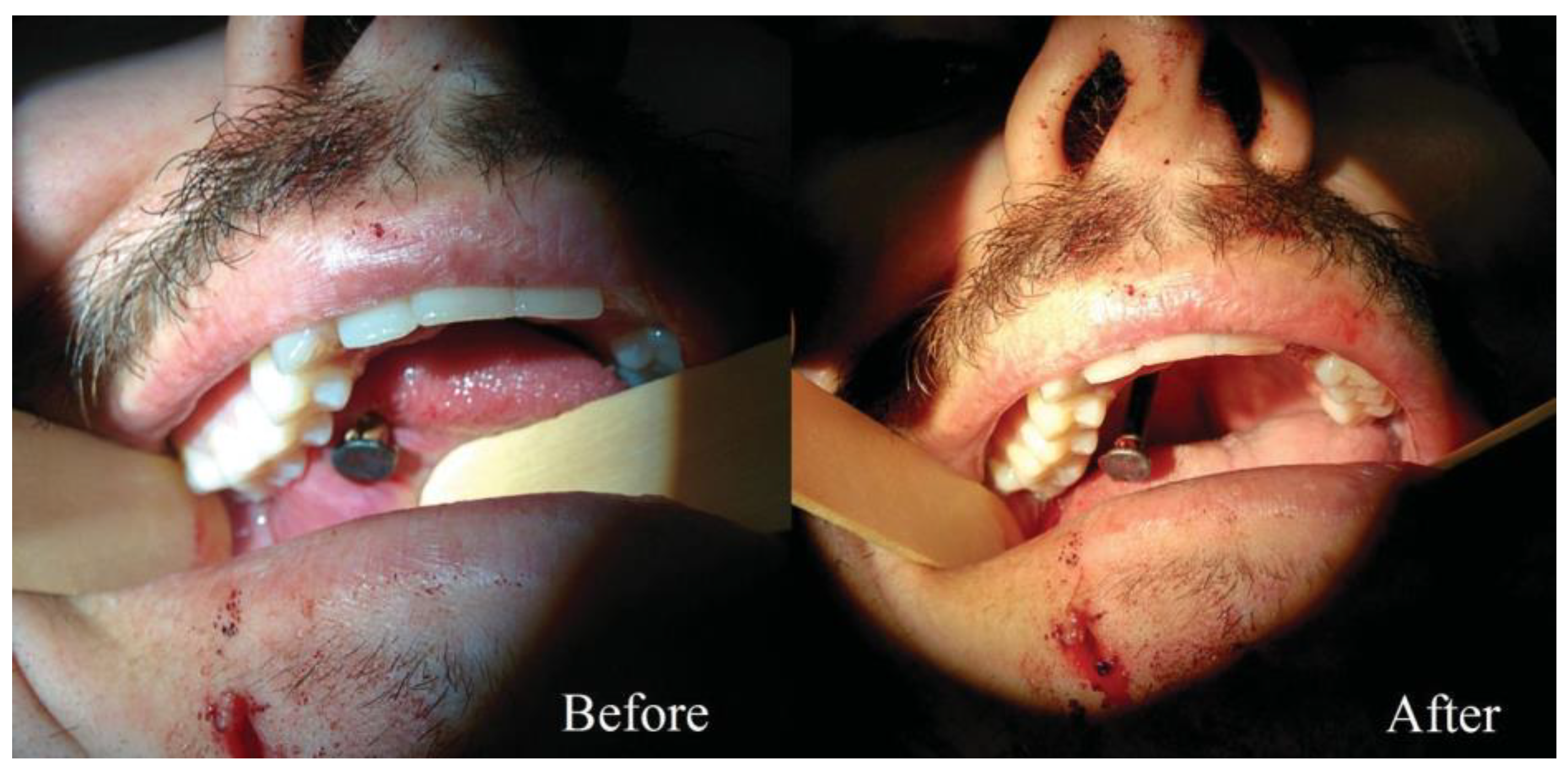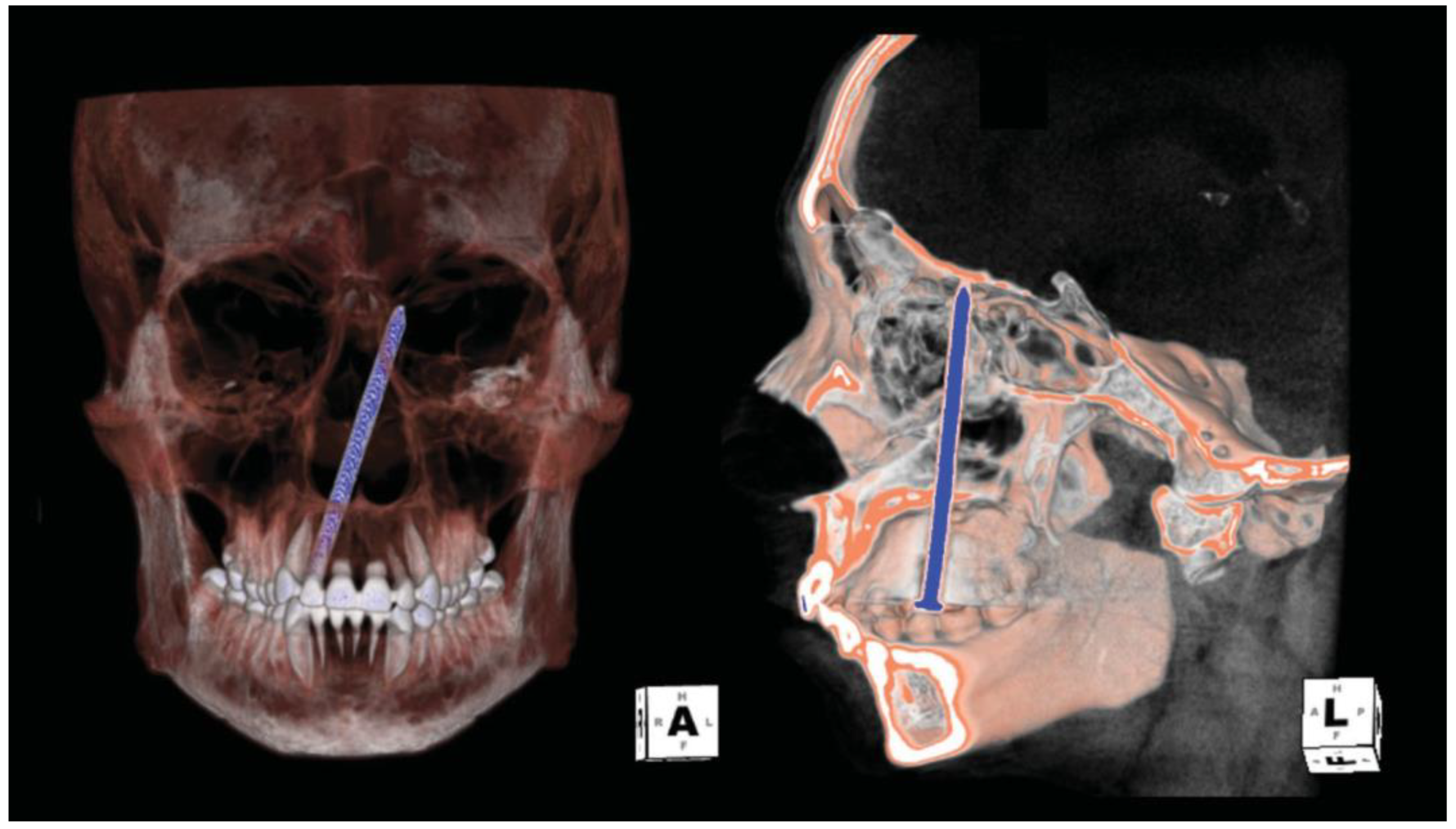Penetrating Craniomaxillofacial Injury Caused by a Pneumatic Nail Gun
Abstract
:References
- Delsol-Liebel, M.A.; Kaminishi, R.M.; Pineda, A. Nail gun injury to the maxillofacial region: Report of a case. J. Oral. Maxillofac. Surg. 1996, 54, 632–634. [Google Scholar] [PubMed]
- Centers for Disease Control and Prevention (CDC). Nail-gun injuries treated in emergency departments—United States, 2001-2005. MMWR Morb. Mortal. Wkly. Rep. 2007, 56, 329–332. [Google Scholar]
- Schaller, B.J.; Kleindienst, A.; Kruschat, T.; Schliephake, H.; Buchfelder, M.; Merten, H.A. Industrial nail gun injury to the anterior skull base: A case report and review of the literature. J. Trauma. 2008, 64, E29–E32. [Google Scholar] [PubMed]
- Buchalter, G.M.; Johnson, L.P.; Reichman, M.V.; Jacobs, J. Penetrating trauma to the head and neck from a nail gun: A unique mechanism of injury. Ear Nose Throat J. 2002, 81, 779–783. [Google Scholar] [PubMed]
- Rezai, A.R.; Lee, M.; Kite, C.; Smyth, D.; Jafar, J.J. Traumatic posterior cerebral artery aneurysm secondary to an intracranial nail: Case report. Surg. Neurol. 1994, 42, 312–315. [Google Scholar] [PubMed]
- Selvanathan, S.; Goldschlager, T.; McMillen, J.; Campbell, S. Penetrating craniocerebral injuries from nail-gun use. J. Clin. Neurosci. 2007, 14, 678–683. [Google Scholar] [CrossRef] [PubMed]
- Advisory Committee on Immunization Practices. Recommended adult immunization schedule: United States, 2012. Ann. Intern. Med. 2012, 156, 211–217. [Google Scholar]
- Lee, A.D.; Oh, Y.S. Unusual delayed presentation of a nail gun injury through the skull base. Laryngoscope 2007, 117, 977–980. [Google Scholar] [PubMed]
- Bruno, J.R.; Levin, L.M.; Stanton, D.C. Pneumatic nail gun injury to the maxillofacial region: Case report. J. Trauma. 1998, 45, 410–412. [Google Scholar] [PubMed]
- Lee, C.S.; Park, K.H. Six nails in the head: Multiple pneumatic nail gun head injury. Br. J. Neurosurg. 2010, 24, 493–494. [Google Scholar] [PubMed]
- Woodall, M.N.; Alleyne, C.H., Jr. Nail-gun head trauma: A comprehensive review of the literature. J. Trauma. Acute Care Surg. 2012, 73, 993–996. [Google Scholar] [CrossRef] [PubMed]



© 2016 by the authors. The Author(s) 2016.
Share and Cite
Choi, K.J.; Ryan, M.A.; Cheng, T.; Powers, D. Penetrating Craniomaxillofacial Injury Caused by a Pneumatic Nail Gun. Craniomaxillofac. Trauma Reconstr. 2017, 10, 159-161. https://doi.org/10.1055/s-0036-1584405
Choi KJ, Ryan MA, Cheng T, Powers D. Penetrating Craniomaxillofacial Injury Caused by a Pneumatic Nail Gun. Craniomaxillofacial Trauma & Reconstruction. 2017; 10(2):159-161. https://doi.org/10.1055/s-0036-1584405
Chicago/Turabian StyleChoi, Kevin Jae, Marisa Ann Ryan, Tracy Cheng, and David Powers. 2017. "Penetrating Craniomaxillofacial Injury Caused by a Pneumatic Nail Gun" Craniomaxillofacial Trauma & Reconstruction 10, no. 2: 159-161. https://doi.org/10.1055/s-0036-1584405
APA StyleChoi, K. J., Ryan, M. A., Cheng, T., & Powers, D. (2017). Penetrating Craniomaxillofacial Injury Caused by a Pneumatic Nail Gun. Craniomaxillofacial Trauma & Reconstruction, 10(2), 159-161. https://doi.org/10.1055/s-0036-1584405


